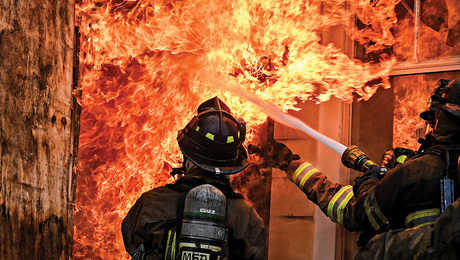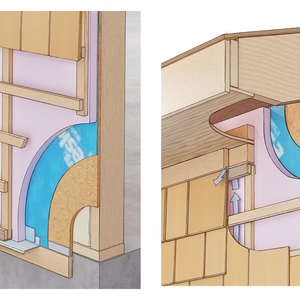Whole house fan and powered roof vent
I have a whole house fan that vents into the atic of a single-story house by way of louvres. I have thought about adding a powered roof vent to the house. My concern is that the powered vent would draw conditioned air from the house into the atic whenever a door is opened, as well as through any air leaks into the house. The house is in a warm suburb of Los Angeles.
Is it safe to install the powered roof vent, or should I stay with the passive wind turbines that are in place now? What is the logic behind the recommendation?



















Replies
Look through the ads in FHB and you will find an insulated whole house fan setup. When on, it raises a pair of insulated doors to allow air to pass into the attic. This will allow you to blast out the hot air in the conditioned space when you want to, and seal it back up again when you don't.
Rebuilding my home in Cypress, CA
Also a CRX fanatic!
If your hair looks funny, it's because God likes to scratch his nuts. You nut, you.
I think this is an either or situation.If you have air conditioning and you are not getting the cool moving around enough, then your HVAC is undersized. In a pinch you could install ceiling fans to spread the cool air around.If you don't have AC, then the whole house fan kicks in and exhausts hot air into the attic and out of the house via vents, screens, turbines and the likes. You need to be careful here because each fan has a rating of input and output. Too much input and not enough output or through put will place a strain on the fan and will accelerate burning out the motor. The same is true with too much output and not enough space for air to be sucked in strains the motor. I've burned out many a power vent here in LA before I discovered this, and it is right on the power vent box, e.g., the number of square feet of vent space you need for a power vent.Regards, Scooter"I may be drunk, but you're crazy, and I'll be sober tomorrow." WC Fields, "Its a Gift" 1934
The house has central A/C and a whole house fan already installed. The fan is usually run in the evenings to draw cooler air into the house and push the hot air out of the atic. A powered vent in the roof would run during the day to pull outside air into the attic and replace the super heated air of the attic. The hope was to reduce the heat mass in the attic and improve the efficiency of the A/C. However, the powered roof vent may pull air into the attic from the house through the fan louvres, as well as through the attic vents, especially when someone opens a door to the outside. If conditioned air is pulled from the house into the attic, it seems like any savings from venting the attic would be lost.
It looks like the plan will be to stay with wind turbines, which are passive.
Not necessarily. If you seal the whole house fan well, and provide plenty of ambient ventilation in the attic, such as gable vents and openings, the power exhaust will draw air from outside to replace the hot attic air.Regards, Scooter"I may be drunk, but you're crazy, and I'll be sober tomorrow." WC Fields, "Its a Gift" 1934
Thanks. Good points.
Seriously, from an earlier suggestion, look at these fans if you are worried about air transferhttp://www.wholehousefan.com/hv-1600.htmland for the attic fan, think about directly replacing the turbines with solar powered attic fans. Should be minimum impact.Something like thishttp://www.solatube.com/homeowner/solarstar.phpI think he combination of the two will do what you want. This is the package that I am fitting on my house in the LA area as we finish off the remodel.jose c.
--
"Though I don't think" added Deep Thought "that you're going to like it."
Thanks for the suggestion of the solar powered fan. I like it. There is a dealer two miles from me.
Currently, the house has three openings for wind turbines. Would you close two of them and install one solar powered vent fan? Or should I put passive, half-moon style attic vents in place of two of the turbines?
I would probably close off the other turbine openings and just use the one fan if the attic is not too big. Check the area ratings to see if one will cover your attic.I have a gable that we put on the attic when we remodeled which I am going to use for one of the gable solar ones.jose c.
--
"Though I don't think" added Deep Thought "that you're going to like it."
Studies have shown that you can move enough air through a attic to make a signficant difference in the air tempature.And you did not give your location.In most areas east of the rockies the air is too humid that if you run a whole house fan at night them the AC will spend the next day removing humidity from the air.I like to use my whole house fan for about 6 weeks in the spring when it is hot, but the humidity level is still down..
.
A-holes. Hey every group has to have one. And I have been elected to be the one. I should make that my tagline.
I live in the San Gabriel Valley, 30 miles east of Los Angeles. The climate is relatively dry. Humidity is seldom an issue when dealing with ventilation or with insulation. In the summer, much of the humidity within the house is created by indoor sources, such as cooking, bathing, or clothes washing.
There is a pretty consistent breeze in the afternoon, which has made wind turbines a popular method of venting attics. With my wind turbines, the attic runs a little cooler than with only the soffit vents and gable end vents that were part of the original construction. However, it still runs much hotter than outside air, creating a warm air mass above the ceiling of the house. In spite of insulation, there is heat transfer.
I am leaning toward keeping the wind turbines but increasing the size from 12 inch to 14 inch diatmeter. Roofers will begin work on Monday morning.
If you have wind from a consistent direction, why not add dormer vents aimed towards the air flow instead?Rebuilding my home in Cypress, CA
Also a CRX fanatic!
If your hair looks funny, it's because God likes to scratch his nuts. You nut, you.
Dormer vents would probably work. The wind direction will most commonly hit the vent openings at a 45 degree angle, perhaps actually pushing air into the attic from the top or restricting the convection out. A neighbor with a house turned 90 degrees to mine uses dormer vents successfully.
My calculations show that I will be better off with 14 inch turbines. I do not need to add soffit venting. Insulation is clear of all of the vent openings.
I will buy the turbines today. The roofers come in the morning.
Jim